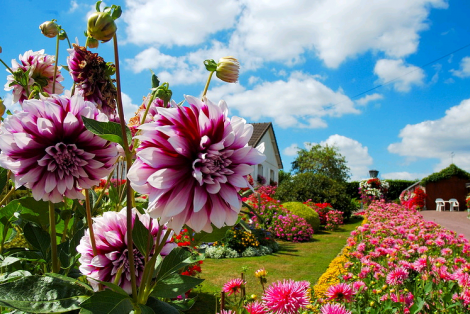Content
- 1 Varietal variety of garlic
- 2 Most popular varieties
- 3 Conclusion
- 4 Spring varieties of the best garlic for planting
- 5 Representatives of the best winter varieties of garlic
- 6 Varietal variety of garlic
- 7 Most popular varieties
- 8 Conclusion
Garlic is an irreplaceable condiment for many dishes. It has a pungent taste and strong aroma. It is endowed with useful properties, therefore it is used as a medicine. Growing garlic is a simple process that does not require a lot of effort and knowledge, so it grows in beds in any garden. The article introduces gardeners to what varieties of garlic are, provides information on the best varieties of garlic, their description and characteristics.
Varietal variety of garlic
More than 70 varieties of garlic have been bred. From this variety, you can choose the appropriate hybrid option for different soil, climatic conditions, location. The experience of gardeners has proven that it is necessary to grow several varieties at once on one site in order to choose the best variety of garlic for your region.
You can choose two varieties for cultivation: early ripening and mid-ripening. Some hybrids of garlic ripen in early summer, they can be added to dishes, used for canning. The harvest of mid-ripening, late-ripening hybrids can be collected only by the end of the summer season, but they are stored for a long time.
Most popular varieties
There are two types of garlic - spring and winter, with different planting dates. Spring garlic should be planted in spring and winter garlic in late autumn. Winter varieties are fruitful, but spring varieties are not very good.
Signs of spring varieties:
- do not have a central rod around which the denticles are located;
- the teeth are in the form of a spiral. Closer to the center, the curling of the teeth decreases;
- the teeth may not be the same shape and size;
- there are no arrows.
Spring Garlic Varieties
Victorio
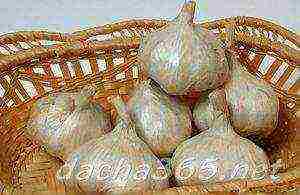 The hybrid belongs to mid-season, high-yielding varieties. The shape of the head is distinguished by a semicircular slightly flattened shape, a yellow-white color of the scales, there are no arrows.
The hybrid belongs to mid-season, high-yielding varieties. The shape of the head is distinguished by a semicircular slightly flattened shape, a yellow-white color of the scales, there are no arrows.
The hybrid is endowed with immunity to fungal diseases and pests.
Yelenovsky
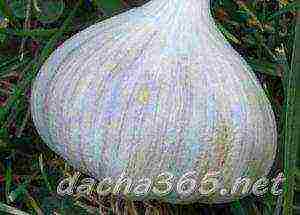 Refers to mid-season, high-yield types of garlic.
Refers to mid-season, high-yield types of garlic.
It is characterized by the presence of rounded heads, resistance to diseases that garlic is exposed to.
The color of the scales is white, and the teeth are pinkish.
Gulliver
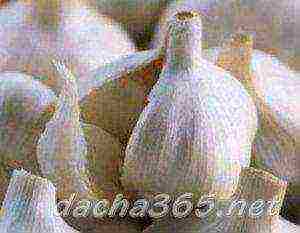 Gulliver belongs to the mid-late, shooting species.
Gulliver belongs to the mid-late, shooting species.
The yield of the variety is high. The bulb has a rounded, slightly flat shape.
The scales of the bulb are endowed with a light color. The variety is not afraid of pests and diseases.
Sochi 56
 Refers to mid-season species, gives a good harvest.
Refers to mid-season species, gives a good harvest.
The color of the scales varies, it can be white or purple. The cooking is rounded, slightly flat. The denticles are pink with a purple tint. Has a strong immunity to diseases.
Ershovsky
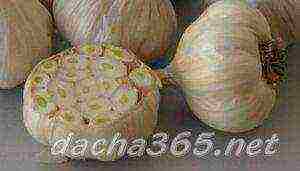 Hybrid "Ershovsky" - mid-season, non-shooting, high-yielding.
Hybrid "Ershovsky" - mid-season, non-shooting, high-yielding.
Its bulbs are endowed with a rounded shape. Disease resistant.
Winter garlic varieties
Characteristics of winter garlic:
- the rod prevails in the very center of the head, around which the denticles are located;
- the arrangement of the teeth is circular;
- all teeth are in one row;
- in appearance, the teeth do not differ;
- has a high yield;
- arrows grow, on which small onions - bulbs are later formed.
Among the many varieties of winter garlic, several of the most popular stand out.
Lyubasha
 The Lyubasha hybrid is perfectly grown in difficult climatic conditions, where drought and severe frosts prevail. The stem of the culture grows up to 120 cm, taking into account the shooting - up to 150 cm. The vegetable has a round, flattened shape. The color of the skin is light, there are streaks of a purple hue. The color of the leaves is green with a waxy bloom. One onion can weigh 120-200 g, but there are only 4-7 cloves inside.
The Lyubasha hybrid is perfectly grown in difficult climatic conditions, where drought and severe frosts prevail. The stem of the culture grows up to 120 cm, taking into account the shooting - up to 150 cm. The vegetable has a round, flattened shape. The color of the skin is light, there are streaks of a purple hue. The color of the leaves is green with a waxy bloom. One onion can weigh 120-200 g, but there are only 4-7 cloves inside.
The vegetable propagates by cloves, airy seeds - bulbs and even a single-toothed bulb. Disease resistant. C1 sq. m you can collect up to 3.5 kg of garlic.
The harvest of garlic is stored for a long time - 10-12 months. The main thing is to follow the storage rules, the place should be dark and cool. When grown, does not require special care.
Dobrynya
 The Dobrynya hybrid gives gardeners a rich harvest, but does not really like the cold. The shape of the head is round, obtuse. Most often, the garlic variety is used for preparing everyday meals. The vegetable ripens late, but it is well stored and is not subject to disease.
The Dobrynya hybrid gives gardeners a rich harvest, but does not really like the cold. The shape of the head is round, obtuse. Most often, the garlic variety is used for preparing everyday meals. The vegetable ripens late, but it is well stored and is not subject to disease.
Sofievsky
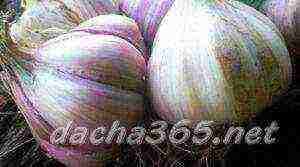 Hybrid "Sofievsky" is not afraid of severe frosts, but in summer it is demanding for heat and light. The culture grows up to 70 cm.
Hybrid "Sofievsky" is not afraid of severe frosts, but in summer it is demanding for heat and light. The culture grows up to 70 cm.
Bulb weight reaches 100 g. The cloves are large enough. Skin color is light purple. The hybrid does not lend itself to the influence of the nematode.
Alcor
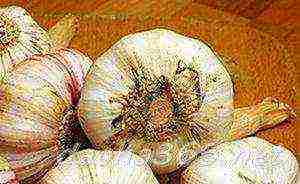 Russian hybrid, bred specifically for the harsh Siberian conditions. If you follow all the rules of cultivation, then from one hectare you can get an excellent harvest - 3-3.4 tons. Bulb weight - 20-35 g, in one bulb, 4 to 6 cloves prevail.
Russian hybrid, bred specifically for the harsh Siberian conditions. If you follow all the rules of cultivation, then from one hectare you can get an excellent harvest - 3-3.4 tons. Bulb weight - 20-35 g, in one bulb, 4 to 6 cloves prevail.
The vegetable can be eaten after 85-95 days. Refers to the type of shooters. Tolerates mechanical planting and cleaning well. You can grow a crop in any soil, but it is best on a drained, non-acidic or aerobic soil. Suitable for growing in Siberia.
Dubkovsky
 The hybrid is characterized by the following positive qualities:
The hybrid is characterized by the following positive qualities:
- high-yielding;
- keeps well;
- spicy taste.
The bulb is not large, weighs no more than 50 g, the stem is of medium height.
Advice! In order for the head to grow to the desired size, it is necessary to trim the arrows at the base. But, in any case, do not break, so as not to damage the bulb.
Shooters
Arrowhead garlic has a pungent flavor and can last long after being harvested. Several popular arrowhead hybrids stand out.
Gribovsky jubilee
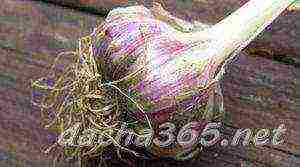 Winter arrow variety with medium-sized bulbs. The skin color is reddish purple. The leaves are quite long, reaching a height of 60-70 cm. The hybrid amazes with an incredibly pungent taste. Disease resistance. You can eat the vegetable 100-105 days after planting. High productivity. With proper care, you can get from one sq. M. 2 kg of garlic.
Winter arrow variety with medium-sized bulbs. The skin color is reddish purple. The leaves are quite long, reaching a height of 60-70 cm. The hybrid amazes with an incredibly pungent taste. Disease resistance. You can eat the vegetable 100-105 days after planting. High productivity. With proper care, you can get from one sq. M. 2 kg of garlic.
Gribovsky 60
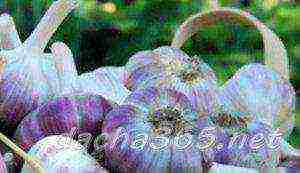 The hybrid is distinguished by its early maturity and high yield. Winter crops are not afraid of severe frosts and droughts.
The hybrid is distinguished by its early maturity and high yield. Winter crops are not afraid of severe frosts and droughts.
The size of the bulb reaches medium parameters. "Gribovsky 60" lends itself to long-term storage and is resistant to bacteria and viruses.
Scythian
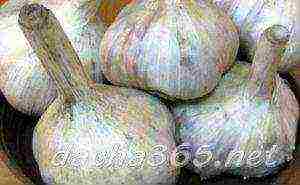 The variety bred for Siberia is frost-resistant. The color of the scales is gray with dark purple veins.
The variety bred for Siberia is frost-resistant. The color of the scales is gray with dark purple veins.
Cream-colored teeth. The hybrid is not afraid of viruses and pests.
Large-toothed Kiseleva
A unique early maturing variety. The head weighs up to 80 g. The taste of the variety is spicy and very pleasant. It is resistant to disease and has a long shelf life.
Hermann
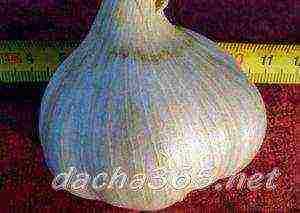 The hybrid is endowed with the following characteristics:
The hybrid is endowed with the following characteristics:
- the growing season lasts 90-100 days;
- leaf length - 60 cm;
- arrowed view;
- the color of the scales is white or purple;
- the head is dominated by 6 to 8 denticles;
- the head reaches large sizes, it can be from the palm of the hand;
- onion weight 70-150 g;
- frost-resistant;
- perfectly stored.
"Herman" is grown in the open field, which contains a neutral amount of acid, at a humidity of 35%. For cultivation, you can choose loamy soil. The hybrid pleases with a rich harvest, from one sq.m. it is possible to get 1kg.
The distance between the holes should be 15-20 cm, between the beds - 20-35 cm. If the garlic is stored in a dark, cool place, then the shelf life will be 8 months.
Non-arrow
The following varieties belong to the non-shooting type of garlic:
 Aleisky - has an average ripening period, a rounded bulb. Useful properties remain until spring;
Aleisky - has an average ripening period, a rounded bulb. Useful properties remain until spring;- Moskovsky - has an average ripening period, has a not very pungent taste. The skin is light in color. The teeth are white;
- Abrek - has a large head. Has similar properties to the Moscow variety;
- Odessa 13 - the variety is divided into two types: winter and spring. The skin color is white with a purple tint. Stored for a long time;
- Gafurian - the bulb of this variety reaches medium size and weighs up to 40 g. The shape is round, slightly flat. The vegetable does not rot, but powdery mildew appears very rarely.
The best large varieties
Among the varieties with a large head, the following are popular:
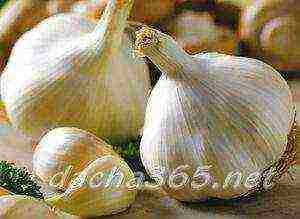 Alekseevskith (giant) - the mass of the bulb reaches 250g. Stored for a long time;
Alekseevskith (giant) - the mass of the bulb reaches 250g. Stored for a long time;- Komsomolets - is a member of the Lukov family. It can be both spring and winter. Not afraid of high temperatures and severe frosts. The size of the bulb reaches 30-50 g, 6-10 cloves prevail inside. The growing season is 110-120 days. The color of the vegetable is purple, the taste is spicy. The size of the leaves is 30-40 cm, they have a light waxy bloom. Grow garlic in a sunny place. Suitable for growing in the Urals;
- Petrovsky - widely used in cooking and for medicinal purposes, has a pungent taste, is resistant to frost. The ripening period of the arrow-shaped winter variety is medium. The ripening period is 100 days. The garlic bulb is small in size, weight - 60-70 g, cloves - 5-7 pcs;
- Degtyarsky - spring, has a moderately pungent taste. The variety has no arrows and is grown in summer;
- Orlovsky - spring, does not release arrows. Bulb weight reaches 100 g.
Conclusion
There are many more different varieties intended for cultivation in the most severe climatic conditions: for Siberia, for the Moscow region. You should not let out of your attention the novelties of selection, for example, Rocambol. A new hybrid that appeared in Russia in 2016. It has the beneficial properties of garlic and onions. Vegetable growers write the best reviews on the forums. Photos of garlic varieties will help inexperienced gardeners make the right choice.
Watch the video! Winter garlic varieties
Garlic is, perhaps, one of the best and most versatile spices, which is suitable not only for cooking, but also as a special touch for salting. But in addition to this, culture is an excellent folk remedy for the treatment of colds, bronchitis and even a whole pack of a wide variety of diseases.
As a result, it is logical that many gardeners are addicted to its cultivation. However, the selection of the best varieties of garlic for a specific region is important for success. This is half the battle! So let's figure out how to find the right solution for different regions.
The best varieties of garlic for SiberiaGiven the region's harsh climate, it is important to “target” the correct winter crop before planting. At the same time, it is important to remember that the plant must withstand quite severe frosts and remain under the snow cap. At the moment, these requirements are fully satisfied:
- Gribovsky Jubilee.The mid-season crop is distinguished by small heads up to 45 grams each. The pungency of the bulbs is too pronounced, therefore, if you want more “fiery” garlic, give preference to Gribovskiy 60. It belongs to the category of early ripening, slightly larger (up to 60 grams) and quite spicy in taste.
- Yelenovsky. In addition to excellent frost resistance, the variety also shows high yields and disease resistance. The bulbs are tightened on average by 50 grams, with up to 7 prongs.
- Saved. This is perhaps the ideal option for those who want to grow the largest garlic, the variety gives heads up to 100 grams each. At the same time, there are few cloves in them - a maximum of 10 pieces.
- Lyubasha. Another of the largest varieties of garlic, which shows good yields even in Siberia. Usually, gardeners manage to get heads weighing up to 130 grams, but for this you need to know how to properly grow Lyubasha's garlic.
Note!
In Siberia, you can get a good harvest of garlic when teeth are used as planting material. If your goal is to breed a good variety, you should give preference to bulbs.
The best varieties of garlic for the Urals Apo se Ural is a rather special place and the climate is exactly the same here. With hot summers and rather frosty winters, he requires strict adherence to the timing of planting crops in the soil and strongly recommends a competent approach to the choice of varieties of garlic, taking into account the acidity and structure of the soil. The most advantageous in this light for the region showed the following hybrids:
- Scythian. Garlic belongs to the late varieties, has excellent taste, strong pulp and good resistance to white rot and bacteriosis.
- Bashkir 85. The winter variety with beautiful bright purple bulbs gives an early harvest. It is extremely rarely affected by oversporosis, onion fly and bacterial rot.
- Sofievsky. A good solution for those who like medium-hot onions. The variety shows a decent yield, but for this, the beds should be located in a well-lit area.
- Dobrynya. In the Urals, it grows just perfectly, delighting with a mid-season harvest. The variety responds very well to watering and weeding, it is well stored for up to six months, and sometimes more. In addition, proper cultivation of Dobrynya garlic guarantees its resistance to many diseases.
Note!
Experienced gardeners do not recommend mulching garlic beds in the Urals, while a roofing or film shelter must be done!
The best varieties of garlic for the Moscow regionThe greatest adaptation to the climate of central Russia, in which, in particular, the Moscow region is located, is shown today by quite a few popular winter varieties. Among them:
- Moscow region. Ideal for temperate climates, it is found in every garden plot and vegetable garden. It is a winter shooting variety with good frost resistance. On average, the onion consists of 5 - 7 prongs and tightens to 60 grams. The taste in the Moscow Region is spicy, the aroma has specific notes.
- Union. Bred by the joint efforts of Russian and Belarusian breeders, the hybrid belongs to the mid-late varieties. It shows consistently good yields and is known for its semi-sharp flavor. In addition, the Union practically does not bring trouble with diseases, since it has good resistance to them.
- Komsomolets. The best results can be achieved when grown in loam. The rather large bulbs are dense in texture and pungent in flavor. The variety is medium late, arrowed.
- Reliable. A universal solution for those who love rich taste and special pungency. In addition, this is perhaps the largest garlic - the variety in this region gives heads up to 75 grams in weight. The bulbs show high resistance to disease and persist for a long time.
- Zubrenok. Will be a godsend for those who need to harvest an early harvest.Rounded bulbs have a rather spicy taste, are excellent as a seasoning for conservation, are resistant to many diseases and show a good yield - about 1.1 kilograms per square meter.
And this, of course, is not all the possible options that can be considered. When choosing planting material, it is important to take into account the climatic specifics of the region, soil requirements, planting time and care features that a particular variety requires.
To get a good harvest of spring or winter garlic from your site, you need to use the best varieties of it, which, depending on the future weather conditions of the area (which affect absolutely everything: potatoes, eggplants, peppers, ...), will give the vegetables corresponding in size ...
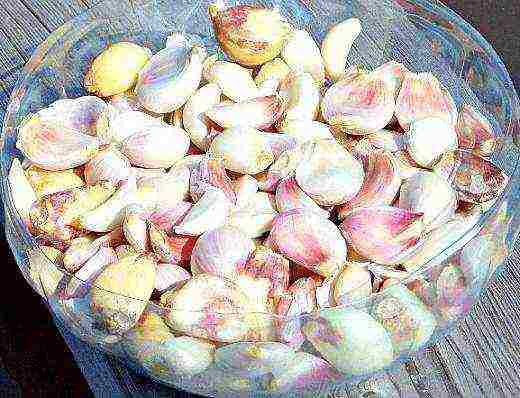
When choosing among unfamiliar names, one should pay attention to their characteristics and the indicated area for which a certain variety is most intended (Internet with reviews to help). Spring (better stored in winter) and winter (more productive) garlic differ in planting time (spring and autumn). The weight below will be given for each representative of these vegetables grown per square meter. meter.
Spring varieties of the best garlic for planting
The best spring garlic varieties are distinguished by their formed heads, which are distinguished by a dense structure. Among other advantages of these vegetables, we note the excellent keeping quality of the product and the return in the form of a good harvest. We plant in the spring. Spring types of garlic are distinguished by early, medium and late ripeness.
Gulliver
Among the best spring types of garlic, one of the leading places is occupied by the Gulliver variety. This is due to the excellent reproduction of culture in garden and vegetable gardens. The main advantages are high disease resistance, good yield and long shelf life. Gulliver is considered a versatile mid-late variety that is great for cooking and preservation. Vegetable culture is characterized by late ripening and a growing season of 88-98 days.
The head weighs about 95-115 grams. There are cases when the weight was more than 250 grams, which was due to the excellent weather, excellent characteristics of the seeds with suitable soil on the site and proper watering of the garden beds. Each onion is covered with gray scales and contains 4-5 large cloves. In terms of taste, Gulliver is considered a rather spicy variety with a yield of 0.9-1.1 kg.
Aleisky
It is included in the list of the best spring representatives of these mid-season vegetables, bred in Western Siberia, it is considered a zoned garlic variety, since it is suitable for planting in this area, but it is successfully in demand in other regions as well. The growing season lasts from 112 to 130 days. Aleisky stands out for its moderate yield, amounting to 0.6-0.7 kg. But there were options when the harvest was more than 1.4 kg with a proper approach to planting and caring for a vegetable crop. The average weight of the head reaches 25 grams, in turn, a clove can weigh up to 4 grams.
In terms of taste, Aleyskiy spring garlic is considered spicy. The main purpose is cooking. Among the disadvantages of the variety, a low resistance to Fusarium disease and bacterial rot is noted.
Sochi 56
Refers to the spring non-shooting subspecies of garlic, which is suitable for planting in small summer cottages. Sochi ripens early, so its growing season lasts 82-93 days (early maturing). Among the advantages, resistance to cold weather conditions and diseases is noted. The matured head is covered with a layer of scales with a strong structure and white color. One head can weigh about 45 grams. Stable in yield - 0.9 kg.
Garlic also has excellent taste due to the presence of sucrose in the composition. A distinctive feature is the storage duration up to one and a half years.

Yelenovsky
Among the best types of spring and winter garlic, one of the first places is occupied by the relatively recently bred Elenovsky variety, included in the State Register for the North Caucasian area. This is due to the best performance in growing in garden and garden plots. The Yelenovsky spring garlic variety is suitable for planting in spring and autumn. It is considered non-shooting and has an average ripening period with a growing season of 110 days. The bulb (7-9 cloves) has a dense structure, dry integumentary scales and a weight of 25-35 grams.
A distinctive feature is frost resistance and resistance to many diseases. The main advantage of such spring garlic is considered to be a long shelf life without losses, which is about 2 years. Since this vegetable grows well, both in spring and in winter planting, it is considered universal. Harvest - 0.9-1 kg.
The Yelenovsky variety is excellent for canning, fresh consumption and cooking. Another advantage of these vegetables is the retention of qualities during transportation.
Permyak
Permyak is a garlic variety intended for growing these vegetables in summer cottages (especially in the northern regions). Refers to non-shooting mid-season (the species was obtained quite recently). It has the following characteristics: the average weight of the head is 34 g, the number of teeth is 15-16 pcs. Has a spicy ("evil", due to the high content of essential oils) taste. It is recommended to store the vegetable for no more than 10 months. The output is up to 0.3 kg of garlic.
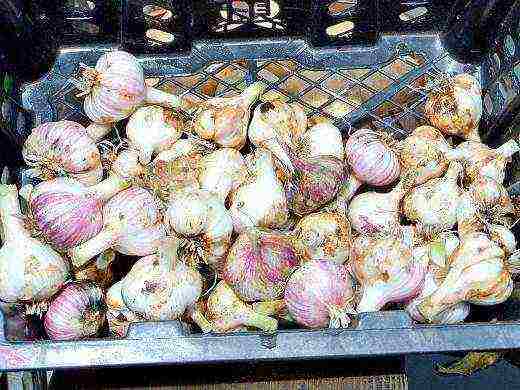
Abrek
Among the best of spring crops is the Abrek garlic variety produced at the All-Russian Research Institute of Breeding and entered in the State Register of Russia. Refers to mid-season non-shooting species. The growing season lasts about 118-120 days. The average weight of one onion is 25 grams, it contains 13 - 16 cloves. Taste characteristics - very spicy. The maximum that turned out was up to 0.8 kg. It is recommended to store vegetable crops for up to 7 months.
Victorio
One of the spring varieties of garlic, Victorio, is included in the State Register and is intended for the cultivation of this peninsular garlic in garden plots. Differs in an average ripening period and growth without arrows characteristic of many varieties. A garlic bulb grows in a round-flat shape weighing about 40 grams, inside which contains 13 cloves. In terms of taste, the variety is distinguished by moderate pungency. Productivity at the level of 0.9 kg. You can store it for 8 months.
Representatives of the best winter varieties of garlic
There are shooting and non-shooting subspecies of vegetable crops. The first subspecies forms heads with 2-6 teeth and arrows with air bulbs. The second subspecies forms a multi-toothed bulb. According to the size of the bulbs of winter species, they are divided into small-toothed, medium-toothed and multi-toothed. These varieties of garlic withstand "strong" winter weather conditions and produce large, tasty bulbs.
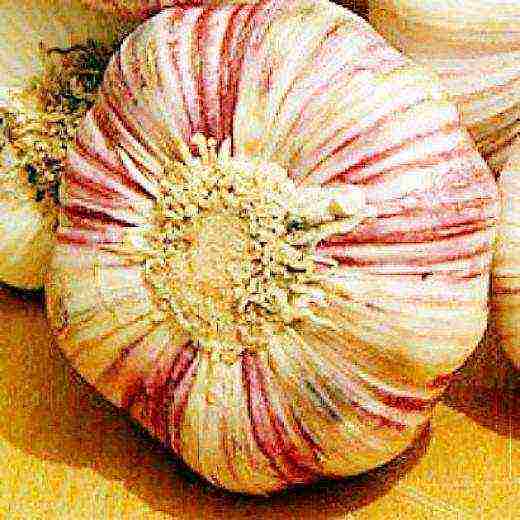
Alcor
A winter arrowhead plant with medium ripeness and a stable yield. The head of Alcor consists of 5 teeth of a simple structure with a lilac shade and dark strokes. Each clove is about 3 mm in diameter and has an oblong shape with a low density. Bulb weight can be from 24 to 35 grams. The tooth, in turn, statistically weighs 3-5 grams on average. The average yield is 3.3-3.6 kg.
This representative of the best varieties of winter garlic is included in the state register for Western Siberia. It is characterized by high resistance to viral diseases. In terms of taste, Alkor is included in the spicy ones. The growing season lasts 90-97 days.
Lyubasha
One of the best winter varieties of garlic is Lyubasha. It is in great demand due to its excellent characteristics.Lyubasha belongs to the shooting subspecies and is distinguished by medium ripeness, high frost resistance and drought survivability. The bulb contains 5-6 cloves of a simple structure. The weight of one slice is from 16-18 gr.
Garlic Lyubasha is intended for planting vegetable crops on Ukrainian and Russian soils. It is considered to be quite sharp. It is also characterized by resistance to Fusarium disease. Lyubasha is a versatile variety due to its special chemical composition. It is great for cooking and preserving. You can grow about 2.8-3.4 kg of such a crop.
Nazus
One of the best, which has established itself in the Middle Urals, the area of which, as you know, is associated with a cold frosty climate. Nazus is an officially registered variety in the Russian Federation and is suitable for planting on a small land area. It belongs to the winter arrowhead species of this vegetable crop, which has a semi-sharp taste. Main characteristics: the bulb weighs up to 60 (and slightly higher) grams, the number of cloves is on average 6, each weighing closer to 12 grams. The variety bred for the Urals, respectively, is winter-hardy. The average yield from it is 1 kg.
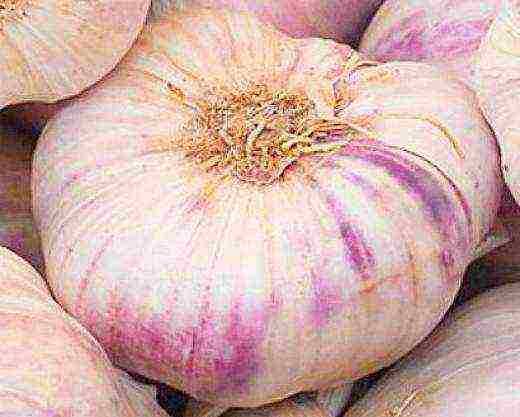
Sofievsky
The winter variety of Sofievsky garlic is intended for use in cooking and is suitable for long storage. Sofievsky is characterized by frost resistance, high yield and excellent taste. In the head (90-110 g, but sometimes more) there are 5-7 cloves. It is flat, slightly rounded, white with lilac veins. The weight of a clove can be up to 18 grams.
A distinctive feature of such winter garlic is good transportability and keeping quality. It is also quite resistant to fungal diseases. Productivity - 1.1-1.8 kg (depending on the place of cultivation).
Losevsky
The Losevsky variety is included in the State Register and is intended for planting vegetables in the garden. Refers to mid-ripening non-shooting species with a growing season of 105-115 days. Losevsky garlic is characterized by large heads weighing up to 75 grams, each of which has 4-5 cloves. Its taste is quite spicy. The yield is good - 1.3-1.9 kg, reaching 2.5. The fruits can be stored for no more than six months. Among the advantages, we single out frost resistance, large heads and a good harvest.
Podmoskovny
Podmoskovny - a variety of garlic included in the State Register, and best of all recommended itself in the Moscow region. Refers to non-shooting mid-season, with a good yield (1.5-1.8 kg) species. The average weight of the bulb is close to 60 grams. It contains 5-7 cloves weighing 10 grams each. In terms of taste, it is considered quite spicy.
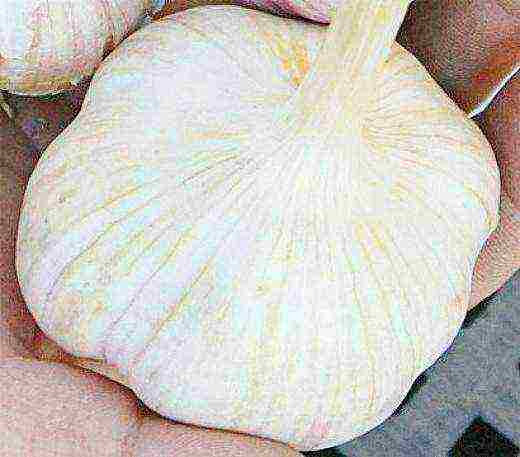
Dobrynya
Dobrynya is considered a weakly sharp succulent variety of a crop belonging to winter crops, characterized by good keeping quality, high yield (2-2.5 kg), frost resistance and resistance to fusarium disease. Refers to a non-shooting type of garlic (an average bulb of 55 grams). Dobrynya is recommended for use in cooking, pickling and canning. Often it is added with vegetable and mushroom preservation, carried out in August and September. Great for cooking as a spice.
This garlic sprouts in mid-April, and ripens after 123-129 days. The vegetable has a shelf life of up to 6 months. Among its shortcomings, drying out with prolonged conservation and rotting of up to 20% of the total mass with a keeping quality of more than 4 months is noted.
Gribovsky 60
It is also included in the cohort of the best winter varieties, which is in demand among summer residents, because it is characterized by rapid maturation and formation of arrows. Among its advantages, resistance to bacterial diseases is noted. At Gribovsky 60, an onion weighing an average of 60 grams grows, but sometimes it reaches 70 grams, inside which there are usually 6-11 cloves. In terms of taste, garlic is spicy.The growing season lasts 90-100 days. The yield reaches 2.6-3.2 kg (but there are too many factors affecting it).
Komsomolets
One of the best winter varieties with high frost resistance is Komsomolets. The vegetable culture has a large and dense head, in which 6-13 cloves are located. The average weight is 90-110 grams. This garlic belongs to the shooting, mid-season subspecies. The ripening period lasts no more than 100 days. It should be noted that Komsomolets has a pungent taste and can be grown about 1-1.4 kg.
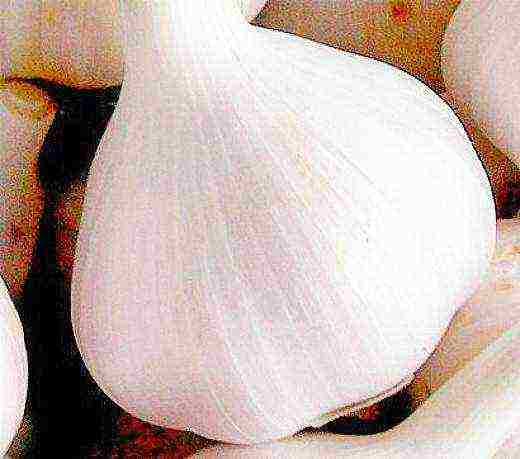
In collaboration with Fateeva Inna Evgenievna.
Garlic is an essential hot spice in cooking. It has a pungent taste and rich aroma and health benefits. Growing garlic is a simple process, therefore, it is on every site. You can find a description of the most popular varieties and varieties in this review.
Varietal variety of garlic
However, not everyone knows that there are more than 70 varieties of garlic! This means that you can choose according to your taste, focusing on the conditions of a particular site with its soil, climate features, location. Moreover growing experience suggests that you should not limit your choice to one or two varieties. It is worth trying a few, and only after leaving the ones you like.
 More than 70 varieties of spring and winter garlic are known
More than 70 varieties of spring and winter garlic are known
Such a variety makes sense, since some ripen earlier and they can be added to dishes already at the beginning - in the middle of summer, used for canning. Others ripen later, but are better stored.
Most popular varieties
Since the varietal variety is great, this article describes popular, popular varieties.
Spring
Spring garlic differs from winter garlic in different planting periods (spring garlic is planted in spring, and winter garlic - in late autumn), yield - spring garlic is less productive, unlike winter garlic.
To visually recognize spring garlic, you need to pay attention to the following signs:
- spring garlic without central bararound which the denticles are located;
- themselves spiral teeth - the closer to the center, the smaller they are;
- teeth can differ from each other by size and shape;
- spring garlicno arrows.
Popular varieties of spring garlic:
Victorio
 Spring Garlic Victorio
Spring Garlic Victorio
Mid-season, high-yielding species. No arrows, resistant to pests and fungal diseases... The bulbs are flat-round in shape, the color of the scales is yellow-white.
Yelenovsky
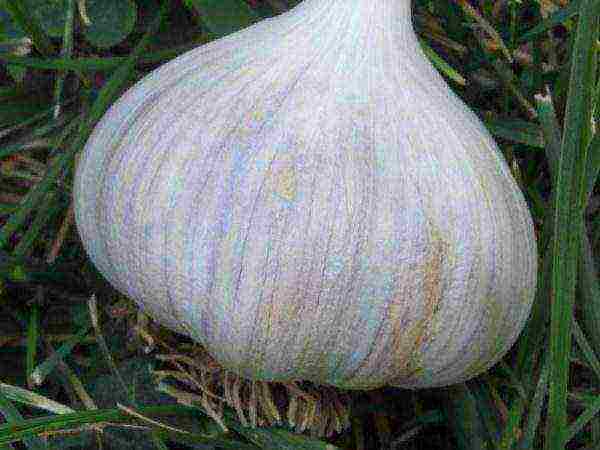 Spring garlic grade Yelenovsky
Spring garlic grade Yelenovsky
Mid-season, fruitful, round heads. Outside, the color of the scales is whitish, and inside, on the teeth themselves, it is pinkish... Demonstrates resistance to all plant diseases.
Gulliver
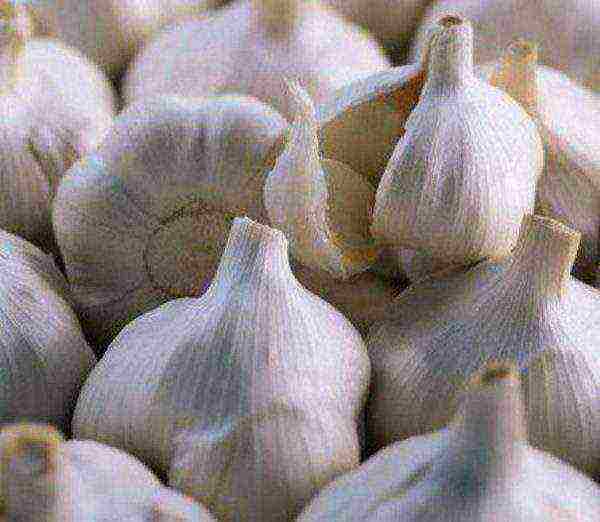 Spring garlic variety Gulliver
Spring garlic variety Gulliver
Considered mid-late. The harvest is good, it produces arrows. The bulb is round, slightly flat. The color of the scales is light, white. Little susceptible to diseases and pests.
Sochi 56
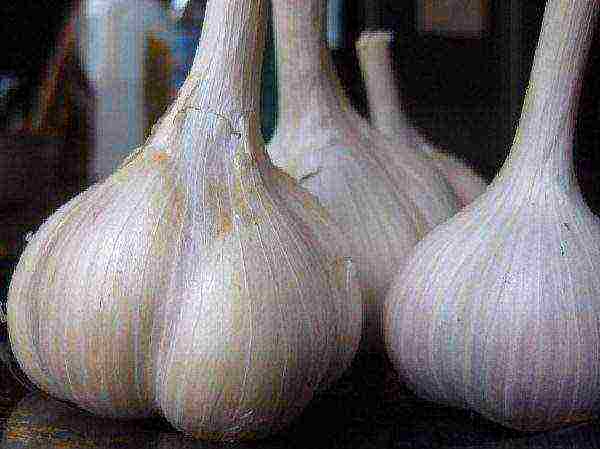 Spring garlic grade Sochi 56
Spring garlic grade Sochi 56
Mid-season, gives a stable and high-quality harvest. The shape of the head is slightly flat, rounded. The color of the scales can be white or purple, and on the teeth themselves - pink with a purple tint. Resistant to disease.
Ershovsky
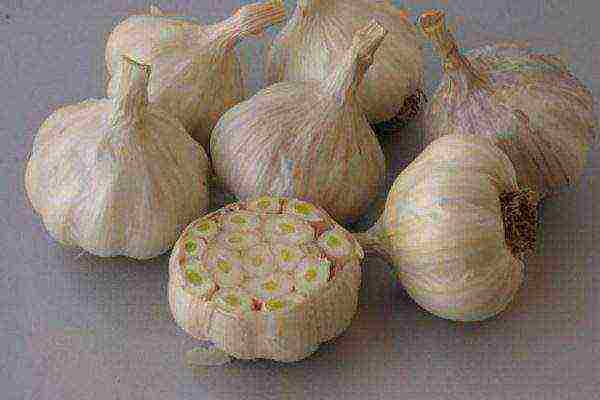 Spring garlic grade Ershovsky
Spring garlic grade Ershovsky
Belongs to mid-season, the bulbs are round, slightly flat. It does not produce arrows, the harvest is excellent. Resistant to disease.
Winter crops
For winter garlic, the following signs are characteristic, by which it can be visually recognized:
- rod in the center of the headaround which the denticles are located;
- the teeth are arranged in a circle, in one row;
- teeth the same;
- harvest gives higher;
- in winter crops -arrows grow on which tiny onions are then formed.
The best-selling varieties of winter garlic are:
Lyubasha
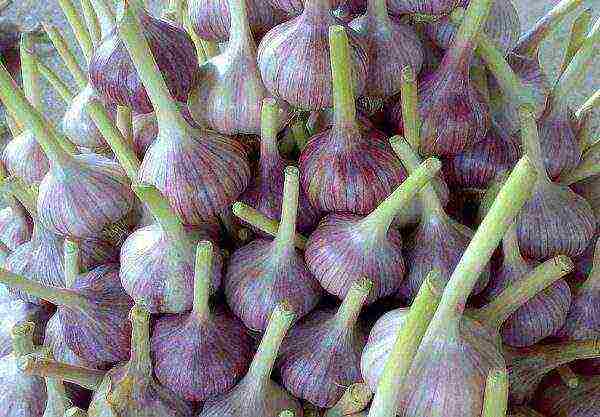 Winter garlic grade Lyubasha
Winter garlic grade Lyubasha
Withstands severe frosts and dry summers. It is considered quite high - the stem is up to 120 cm. The bulb is round, slightly flat.The color of the scales is light with streaks of violet tones, resistant to diseases. Keeps perfectly. It has a bright spicy taste and is suitable for canning.
Dobrynya
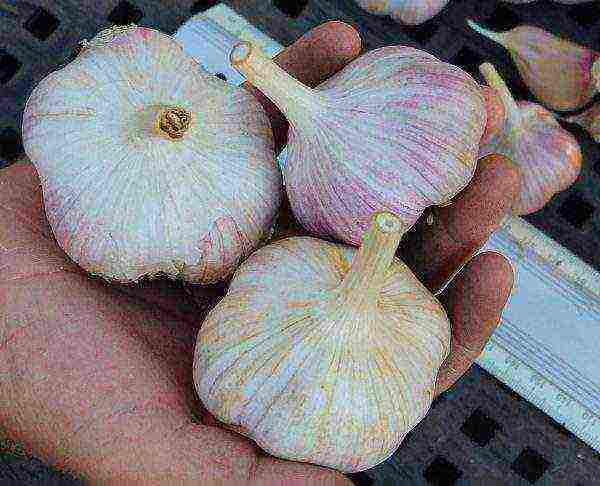 Winter garlic variety Dobrynya
Winter garlic variety Dobrynya
A productive variety, but less frost-resistant than Lyubasha. The heads are large, not too sharp, so it is good to eat it fresh. Ripening period - late. Dobrynya is well kept and is not susceptible to disease.
Sofievsky
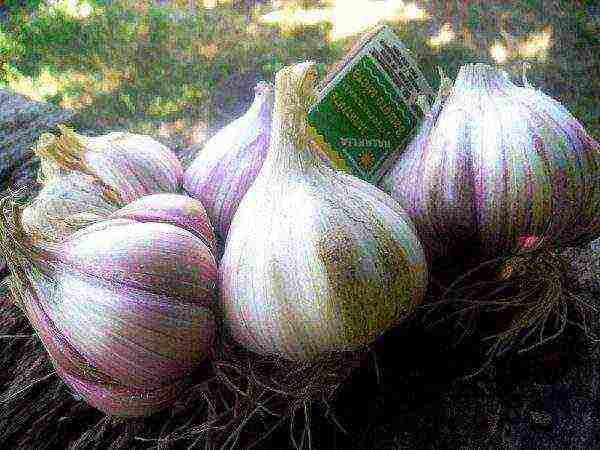 Winter garlic Sofievsky grade
Winter garlic Sofievsky grade
It perfectly tolerates severe frosts, but in summer it is picky about heat and light. Not too high - about 70 cm. Large onion - 100 g with large cloves. The color of the scales is pale purple. Nematode resistant, moderately pungent taste.
Alcor
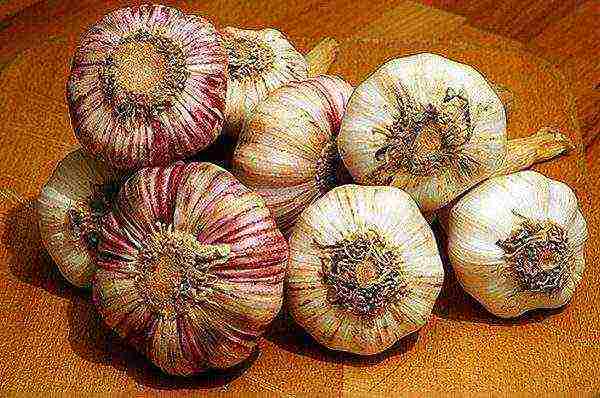 Winter garlic grade Alkor
Winter garlic grade Alkor
High-yielding, excellent storage. The color of the bulb is pinkish, and the cloves themselves are closer to gray. Damaged by yellow dwarfism.
Dubkovsky
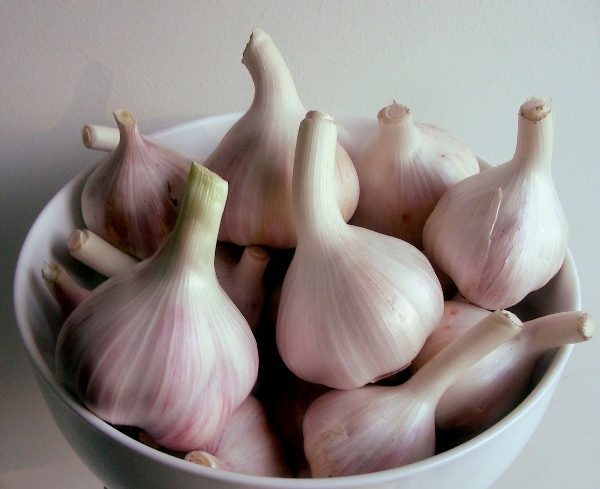 Winter garlic variety Dubkovsky
Winter garlic variety Dubkovsky
High yielding, good storage performance. The stem is of medium height, the bulb is not large, rarely weighs more than 50 grams. It is stored excellently, the taste is spicy.
In winter crops, it is imperative to cut off the arrows at the base, otherwise the head will be shallow. Do not break the arrows so as not to damage the bulb.
Shooters
Garlic that produces arrows is sharper in taste, more productive than varieties without arrows, it is better stored. Among the shooters, the most noticeable are:
Gribovsky jubilee
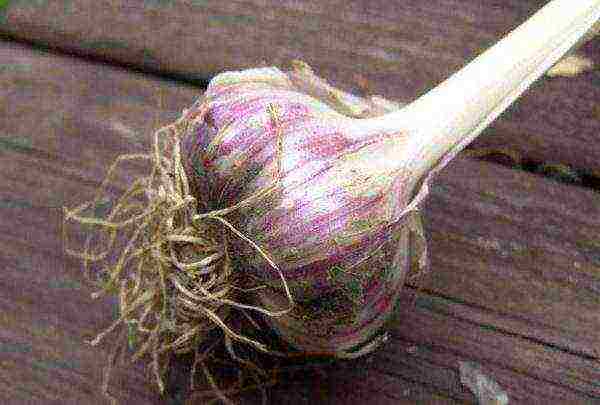 Shooting garlic variety Gribovsky jubilee
Shooting garlic variety Gribovsky jubilee
Medium-sized winter variety. The color of the scales is reddish-purple. Disease resistance - at a high level, stored well.
Gribovsky 60
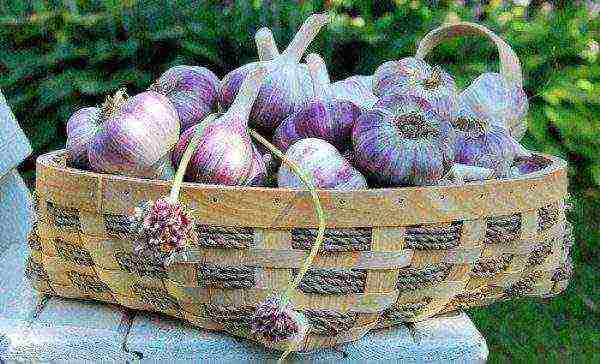 Shooting garlic grade Gribovsky 60
Shooting garlic grade Gribovsky 60
Harvest early ripening, resistant to freezing and drought. The bulb is medium in size and keeps well. Not damaged by bacteria and viruses.
Scythian
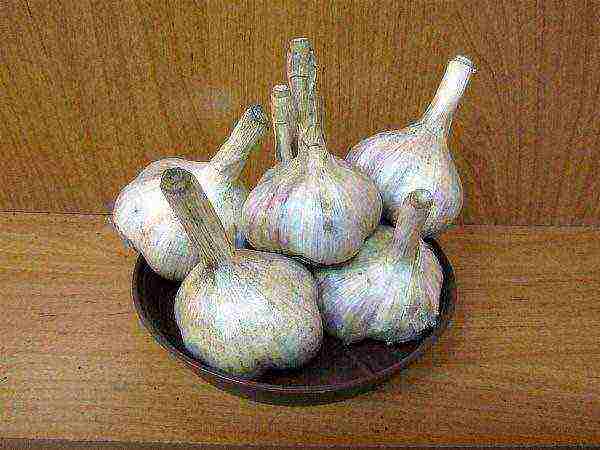 Shooting garlic grade Skif
Shooting garlic grade Skif
Frost-resistant variety, resistant to diseases of this plant. The color of the scales is gray with streaks of purple, and the teeth themselves are creamy.
Large-toothed Kiseleva
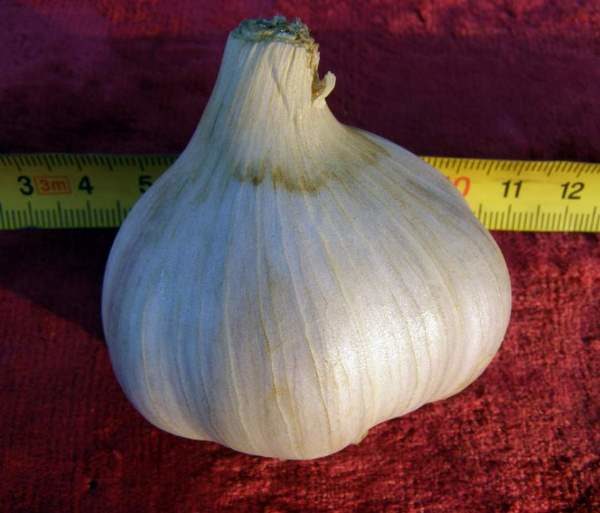 Shooting garlic grade Skif
Shooting garlic grade Skif
Early ripening, the head is more than average, about 80 g, the taste is pleasant, spicy. It is not susceptible to disease, shelf life is long.
Hermann
 Garlic variety Herman
Garlic variety Herman
The bulb is round, conical, the color of the scales is whitish-lilac, and the cloves are cream. Stored up to 8 months, resistant to fungal and bacterial infections.
Non-arrow
Of the non-shooting, the following are popular:
Aleisky
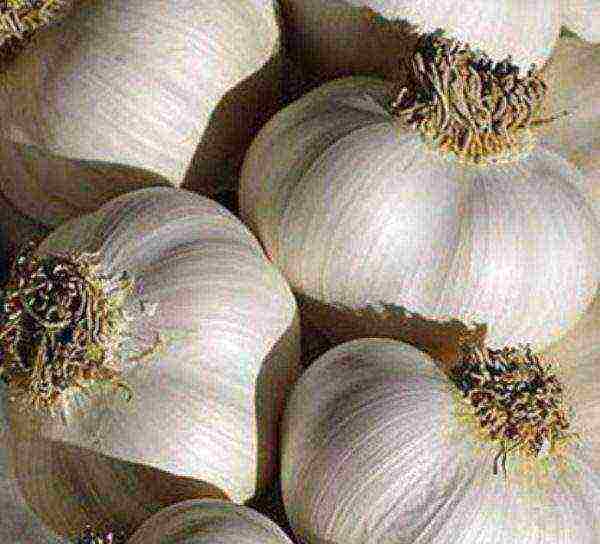 Aleisky garlic variety
Aleisky garlic variety
Mid-season, round bulb, flat, stored until spring.
Moskovsky
 Garlic variety Moscow
Garlic variety Moscow
Mid-season, well kept, not too sharp the color of the scales is light, the teeth are white.
Abrek
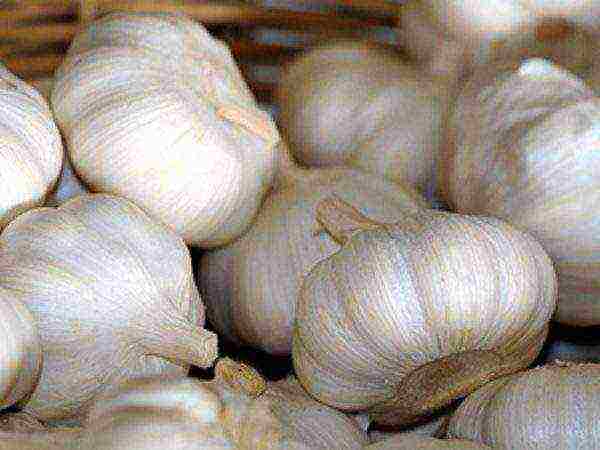 Garlic variety Abrek
Garlic variety Abrek
Similar to Moscow, but the head is slightly larger.
Odessa 13
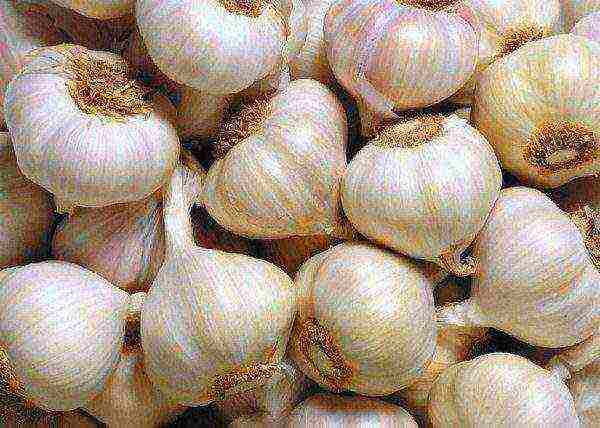 Garlic variety Odessa 13
Garlic variety Odessa 13
It happens spring and winter, the color of the scales is white, sometimes with stripes of purple tones, stored wonderfully.
Gafurian
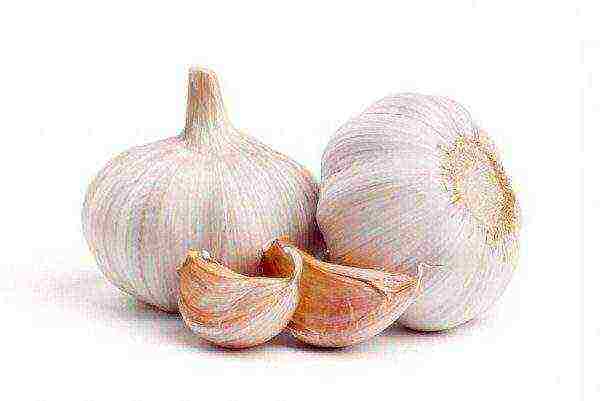 Garlic variety Gafurian
Garlic variety Gafurian
Medium-sized onion up to 40 grams, round, flat. Resistant to rot, but sometimes it is prone to powdery mildew.
The best large varieties
Of the varieties with a large head, the following are known:
Alekseevsky (giant)
 Garlic Alekseevsky (giant)
Garlic Alekseevsky (giant)
The bulb reaches 250 gr. Wherein resistant to diseases and stored for a long time.
Komsomolets
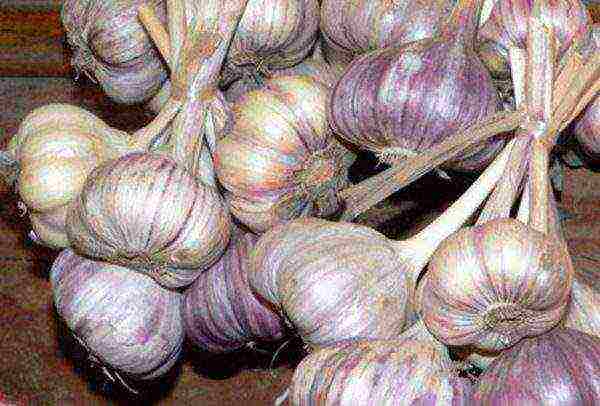 Garlic Komsomolets
Garlic Komsomolets
Shooting, winter, mid-season, flat-round onion, the taste is pungent.
Petrovsky
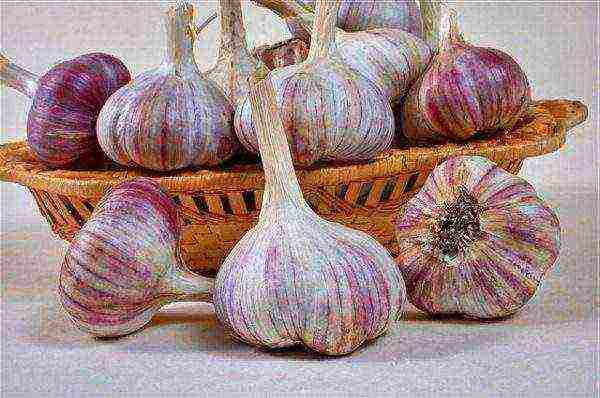 Petrovsky garlic
Petrovsky garlic
Looks like Komsomolets, resistant to disease.
Degtyarsky
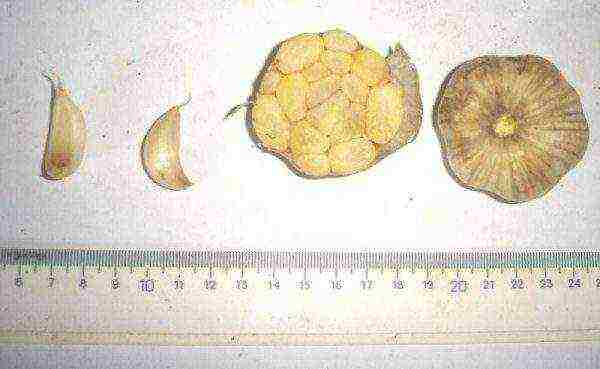 Degtyarsky garlic
Degtyarsky garlic
Spring, without arrows, the taste is moderately spicy.
Orlovsky
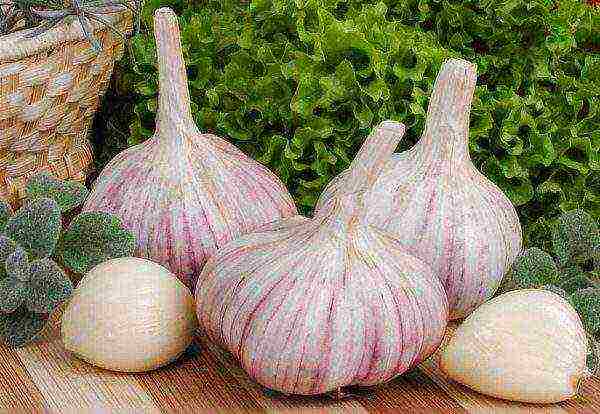 Garlic Orlovsky
Garlic Orlovsky
Spring, does not release arrows, onion over 100 gr.
Conclusion
These are not all varieties of garlic that are worthy of attention. AND do not be afraid to try new selection - there are many good varieties among them!
